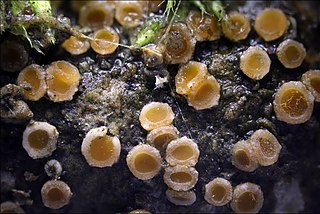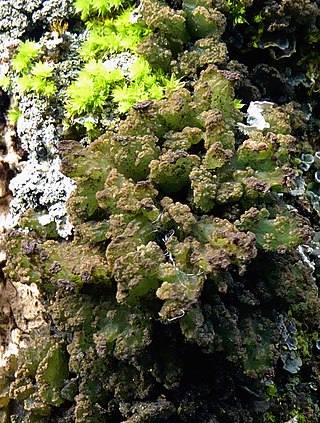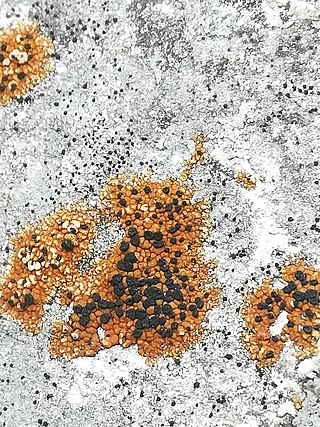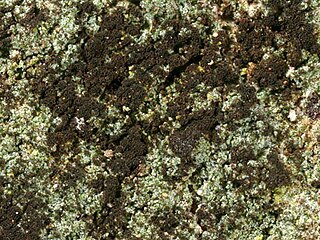
Gyalectales is an order of lichen-forming fungi in the class Lecanoromycetes. It contains 5 families, 15 genera and about 550 species.

The Arthoniaceae are a family of lichenized, lichenicolous and saprobic fungi in the order Arthoniales. The Arthoniaceae is the largest family of Arthoniales, with around 800 species. Most species in Arthoniaceae belong in Arthonia which is the largest genus with 500 species. The second and third largest genus is Arthothelium with 80 species, and Cryptothecia with 60 species.

The Roccellaceae are a family of fungi in the order Arthoniomycetes. Most taxa are lichenized with green algae, although some are lichenicolous, growing on other lichens.
Ancistrosporella is a genus of lichen-forming fungi in the family Roccellaceae. The genus was circumscribed in 1995 by Swedish lichenologist Göran Thor, with Ancistrosporella australiensis assigned as the type species.
Didymocyrtis is a genus of lichenicolous fungi in the family Phaeosphaeriaceae. The genus was circumscribed by Finnish lichenologist Edvard August Vainio in 1921, with Didymocyrtis consimilis assigned as the type species.
Tylophoron is a genus of lichen-forming fungi in the family Arthoniaceae. The genus was circumscribed in 1862 by Finnish lichenologist William Nylander.

Gyalecta is a genus of lichen-forming fungi in the family Gyalectaceae that contains 50 species. Gyalecta was circumscribed by lichenologist Erik Acharius in 1808. It forms associations with Trentepohlia algae.

Ramonia is a genus of lichenized fungi in the family Gyalectaceae. It contains 24 species. The genus was circumscribed by Ernst Stizenberger in 1862.

The Arctomiaceae are a family of lichenized fungi in the Ascomycota, class Baeomycetales. The family was named by Theodor Magnus Fries in 1861, with Arctomia as the type genus. Species in this family are found in arctic and subarctic habitats, usually associated with bryophytes.
Synarthonia is a genus of lichen-forming fungi in the order Arthoniales. The genus has not been placed into a family. Synarthonia was circumscribed by Swiss lichenologist Johannes Müller Argoviensis in 1891.

Phoebus is a fungal genus of previously uncertain familial placement in the order Arthoniales, now placed in the family Lecanographaceae thanks to molecular analyses. It contains only one species, Phoebus hydrophobius, found in the Ozarks of the central United States, and described as new to science in 2007.

Malmideaceae is a family of crustose and corticolous lichens in the order Lecanorales. It contains eight genera and about 70 species.
Inoderma is a genus of lichen-forming fungi in the family Arthoniaceae. It was resurrected for use in 2015 for a small group of species with the following features: elevated, white pruinose pycnidia, immersed to adnate white pruinose apothecia, and a weakly gelatinized hymenium. Inoderma byssaceum was assigned as the type species for the genus.
Phylloblastia is a genus of foliicolous (leaf-dwelling) lichens in the family Verrucariaceae. The genus was circumscribed in 1921 by Finnish lichenologist Edvard August Vainio, with Phylloblastia dolichospora assigned as the type species.
Pyrenidium is a genus of lichenicolous (lichen-dwelling) fungi. It is the only genus in the family Pyrenidiaceae. It has 13 species.

Reichlingia is a genus of lichen-forming fungi in the family Arthoniaceae. It has seven species. The genus was originally circumscribed by Paul Diederich and Christoph Scheidegger in 1996, with Reichlingia leopoldii as the type, and at that time, only species. The fungus was at first thought to be a lichenicolous (lichen-dwelling) fungus, but is now considered a lichenised hyphomycete.

Nigrovothelium is a genus of lichen-forming fungi in the family Trypetheliaceae. It has three species. The genus was circumscribed in 2016 by lichenologists Robert Lücking, Matthew Nelsen, and André Aptroot, to contain species formerly in the Trypethelium tropicum species group. The type species, Nigrovothelium tropicum, was originally described by Erik Acharius in 1810, as a species of Verrucaria.
Isalonactis is a monotypic fungal genus in the family Roccellaceae. It contains the single species Isalonactis madagascariensis, a saxicolous (rock-dwelling), crustose lichen found in Madagascar. Both the genus and species were described as new in 2014 by Damien Ertz, Anders Tehler, Eberhard Fischer, Dorothee Killmann, Tahina Razafindrahaja, and Emmanuël Sérusiaux. The type was collected on the Isalo Massif at an altitude of 851 m (2,792 ft); there, it was found growing on sheltered mesozoic sandstone cliffs. The genus name alludes to both Isalo Massif, the type locality, and the phylogenetic relatedness to genus Lecanactis.
Ocellomma is a genus of lichen-forming fungi in the family Roccellaceae. The genus was circumscribed in 2014 by Damien Ertz and Anders Tehler, following a molecular phylogenetic-based revision of the Roccellaceae. The type species, O. picconianum, was originally named Lecania picconiana by Francesco Baglietto in 1862, described from specimens collected in Italy. DNA-based phylogenetic analysis showed that it occupied a distinct genetic lineage, deserving of recognition as a new genus. The genus name Ocellomma alludes to the whitish rims on the small ascomata that contrast with the discs, giving them the appearance of small eyes.

Fulvophyton is a genus of lichen-forming fungi in the family Roccellographaceae. It has 11 species. Fulvophyton is characterised by its crust-like thallus, which is often pale yellowish-brown in colour. This genus features a photobiont from the green algal genus Trentepohlia and exhibits a unique arrangement of reproductive structures.











